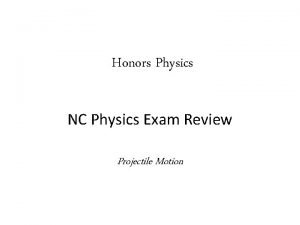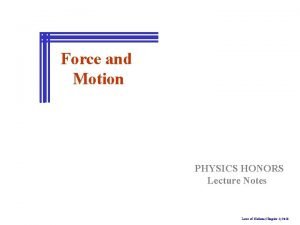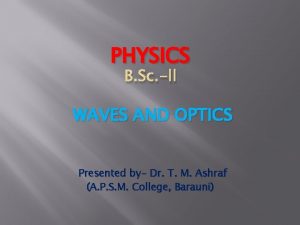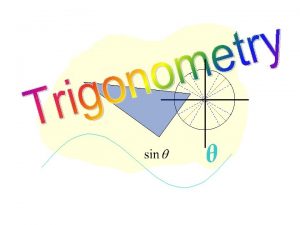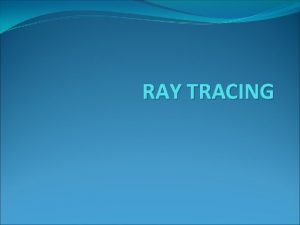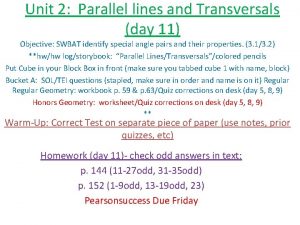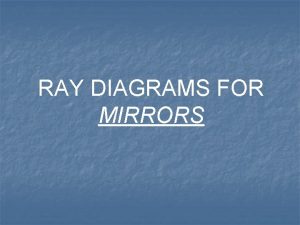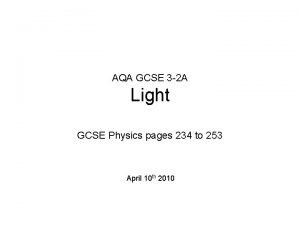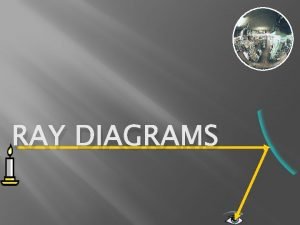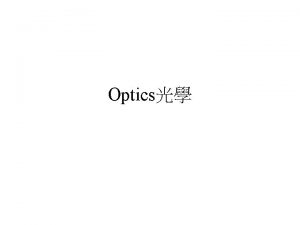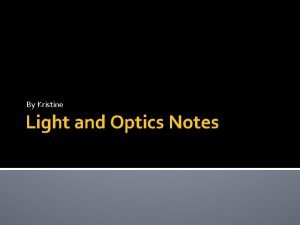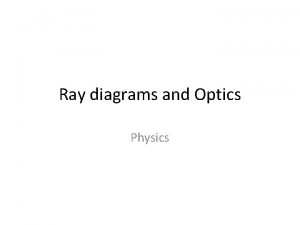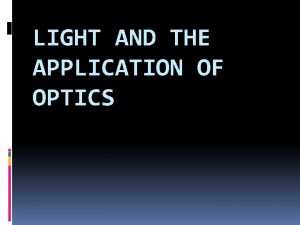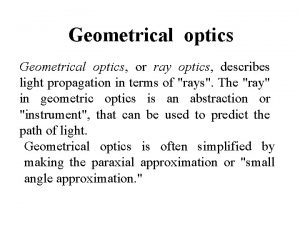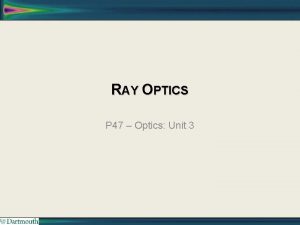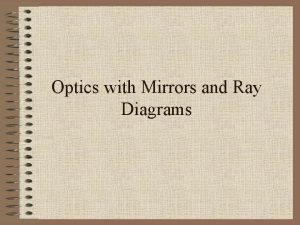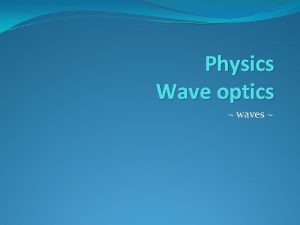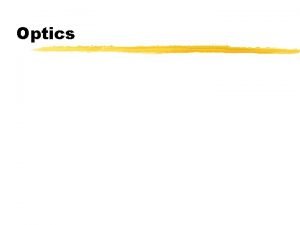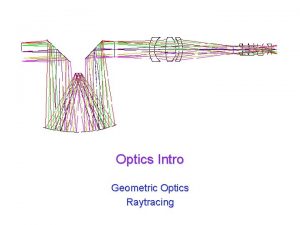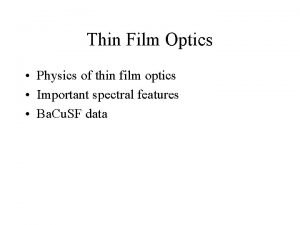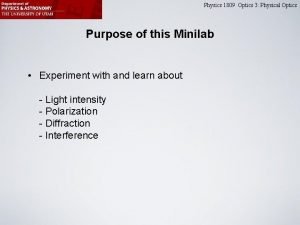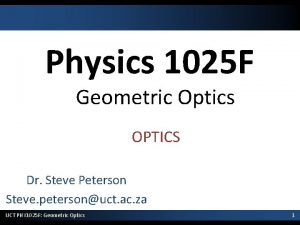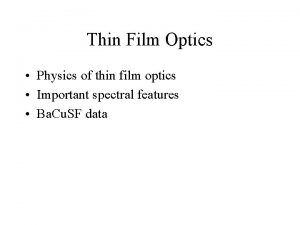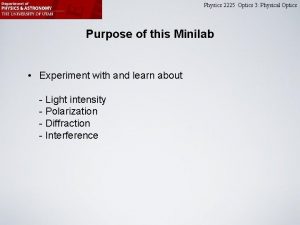Ray diagrams and Optics Honors Physics Ray diagrams





















- Slides: 21

Ray diagrams and Optics Honors Physics

Ray diagrams • Light travels in straight paths so we • Three light rays you can draw for can draw rays mirrors: • We will draw representative light rays 1. A light ray coming in parallel to the that will show where an image forms axis will reflect through f based on how it reflects off a mirror 2. A light ray coming through f will (or refracts in a lens) reflect parallel • How light reflects (or refracts) 3. A light ray into the center of the depends on the curvature of the mirror will reflect at the same mirror or lens and the law of reflection incoming angle (law of reflection at (or snell’s law) the flat part of the mirror) • Center of curvature or radius of curvature (C) is 2 x the focal length (f)

Concave mirror—object outside C A light ray coming in parallel to the axis will reflect through f Light rays intersect, so this is a real image. Image is smaller, upside down, between C & f C f A light ray coming through f will reflect parallel

Mirror/Lens Equation Magnification - the number of times larger an object appears as seen by the naked eye (negative means upside down, less than 1 is smaller and greater than 1 is larger) f=focal length di= image distance do= object distance

Example using equations A candle is placed in front of a concave mirror with a focal length of 10 cm. The candle is 40 cm away from the mirror. Where will the image form? What is the magnification? M = -di = - 13. 3 cm = -0. 333 do 40 cm

Concave mirror—object at C A light ray coming in parallel to the axis will reflect through f Light rays intersect, so this is a real image Image is same size, upside down, at C C f A light ray coming through f will reflect parallel

Concave mirror—object between C & f A light ray coming in parallel to the axis will reflect through f Light rays intersect, so this is a r Image is larger, upside down, o C f A light ray coming through f will reflect parallel

Concave mirror—object at f A light ray coming in parallel to the axis will reflect through f C f A light ray into the center of the mirror will reflect at the same incoming angle Light rays are parallel, so there is NO IMAGE formed.

Concave mirror—object inside f A light ray coming in parallel to the axis will reflect through f C f A light ray into the center of the mirror will reflect at the same incoming angle Light rays intersect behind mirror, so this is a VIRTUAL image. Image is larger, right side up, and appears inside mirror.

Convex Mirror A light ray coming into center will reflect at same angle. segami LAUTRIV smrof syawla siht os , rorrim eht dniheb tcesretni syar thgi. L. rorrim eht edisni sraeppa dna , pu edis thgir , rellams si egam. I serots ni srorrim ecnallievrus , rorrim weiv edis regnessap , srorrim sub : ses. U

Ray diagrams for lenses • Light travels in straight paths so we can draw rays • We will draw representative light rays that will show where an image forms based on how it refracts in a lens • How light refracts depends on the curvature of the lens and snell’s law • Center of curvature or radius of curvature (C) is 2 x the focal length (f) • Three light rays you can draw for lenses: 1. A light ray coming in parallel to the axis will refract through f 2. A light ray coming through f will refract parallel 3. A light ray into the center of the lens will pass straight through the lens

Convex lens—object outside C A light ray coming in parallel to the axis will refract through f f C A light ray coming through f will refract parallel f o this is a real image. ide down, between C & f C

Convex lens—object at C A light ray coming in parallel to the axis will refract through f intersect, so this is a real image. ame size, upside down, at C C A light ray coming through f will refract parallel f f C

Convex lens—object between C & f A light ray coming in parallel to the axis will refract through f rsect, so this is a real image. r, upside down, outside C A light ray coming through f will refract parallel f C C

Convex lens—object at f A light ray coming in parallel to the axis will refract through f C f f A light ray going through center of lens goes straight through Light rays are parallel, so there is NO IMAGE formed. C

Convex lens—object inside f A light ray coming in parallel to the axis will refract through f C f f A light ray going through center of lens goes straight through Light rays trace back inside lens so this is a VIRTUAL image. Image is larger, right side up, inside lens. (This is a magnifying glass. Something is magnified only when held inside f. ) C

Example using equations A candle is placed in front of a convex lens (a magnifying glass) with a focal length of 10 cm. The candle is 5 cm away from the lens. Where will the image form? (-) means VIRTUAL M = -di = - (- 10 cm ) = + 5 do 2 cm (+) means 5 x larger right side up

Concave lens (a diverging lens) A light ray coming in parallel to the axis will diverge a si siht os snel edisni kcab ecart syar thgi. L. egami LAUTR V ray going through center A Ilight. snel edisni , pu edis thgir , rellams si ega I ofmlens goes straight through lens segami sekam syawla snel evacnoc A. lautriv dna rellams

How your eye works Your eye has a convex lens of your eye focuses a real, smaller, upside down image on the back of your retina. Your brain flips the image right side up.

Near sighted corrected with diverging lens Focus is NOT on the retina vs. Far sighted corrected with converging lens Corrected vision with lenses

 Difference between ray optics and wave optics
Difference between ray optics and wave optics Venn diagram of geometric optics and physical optics
Venn diagram of geometric optics and physical optics Honors physics semester 1 review
Honors physics semester 1 review Vyi physics
Vyi physics Physics honors notes
Physics honors notes Wave optics b.sc physics
Wave optics b.sc physics The interaction diagrams, use case diagrams are called as
The interaction diagrams, use case diagrams are called as Activity diagram if
Activity diagram if Initial ray definition
Initial ray definition Ray tracing and ray casting
Ray tracing and ray casting Deped order no.36 s.2016
Deped order no.36 s.2016 Ucsb honors college
Ucsb honors college Honors geometry parallel lines and transversals worksheet
Honors geometry parallel lines and transversals worksheet Image formed by plane mirror
Image formed by plane mirror Lenses bbc bitesize
Lenses bbc bitesize Diverging lens concave
Diverging lens concave Convex lens image
Convex lens image Physics 241
Physics 241 Disadvantage of optical fiber
Disadvantage of optical fiber Light and optics notes
Light and optics notes Infrared light is also known as bill nye
Infrared light is also known as bill nye Microphone energy transfer
Microphone energy transfer



